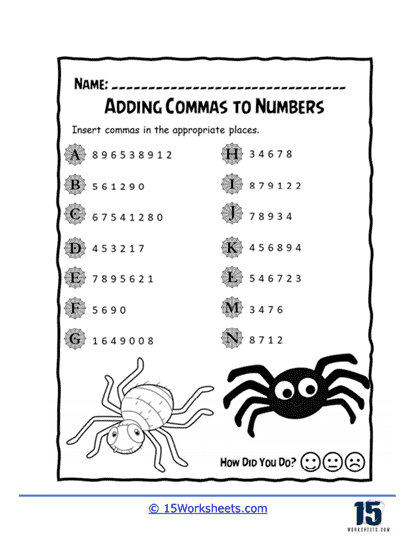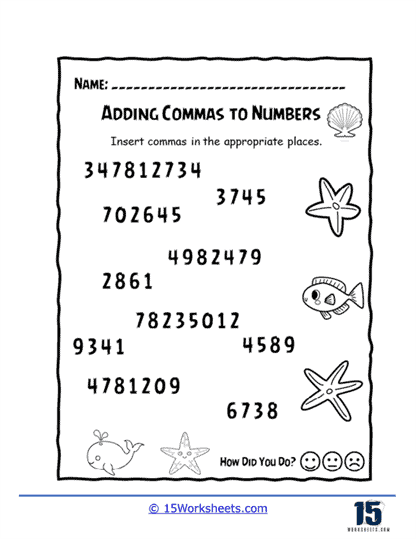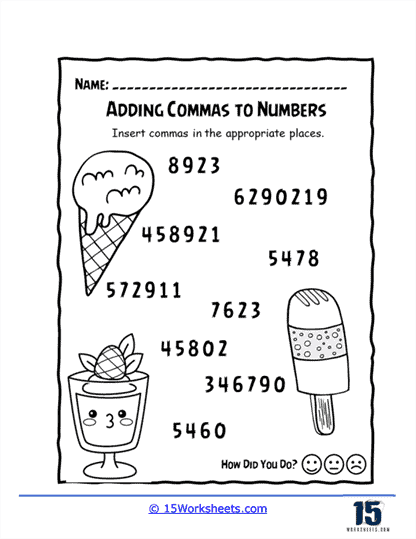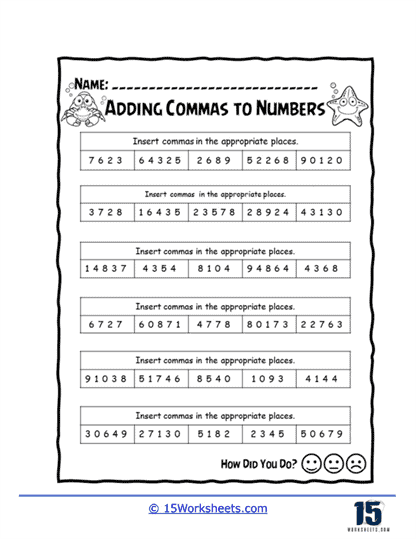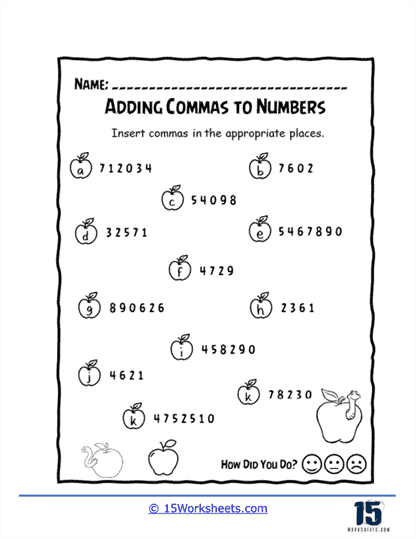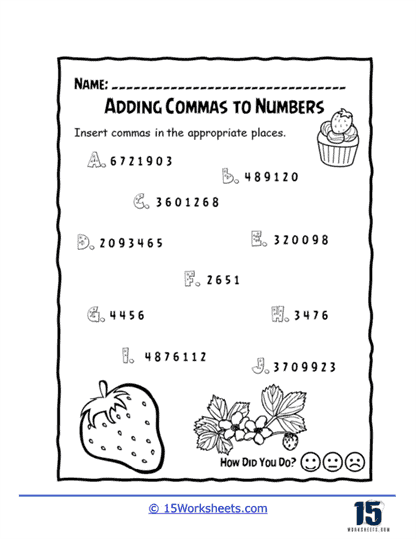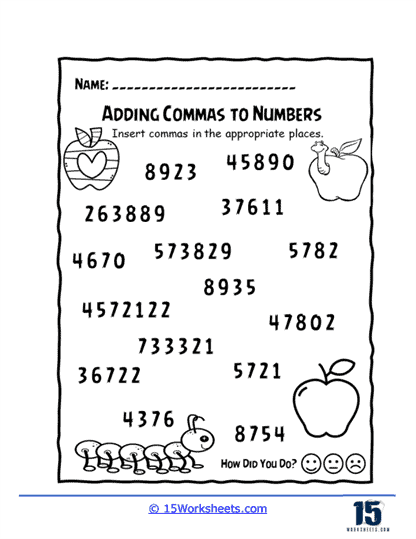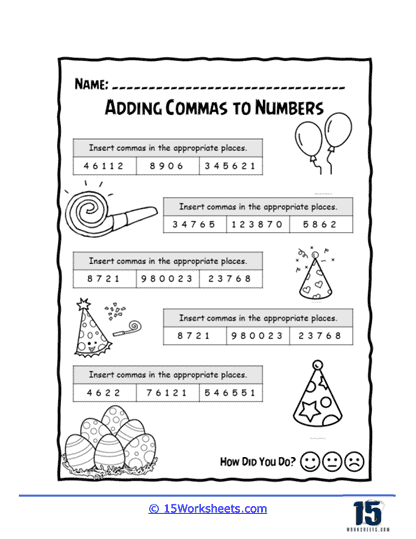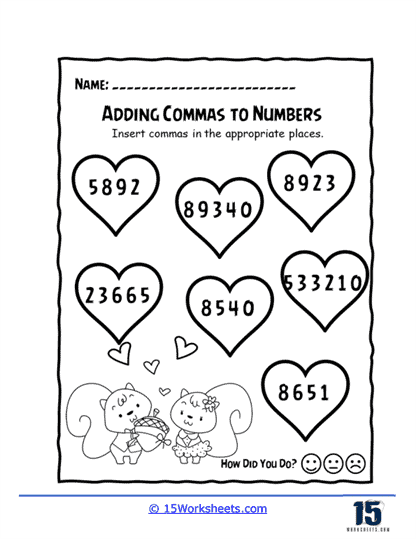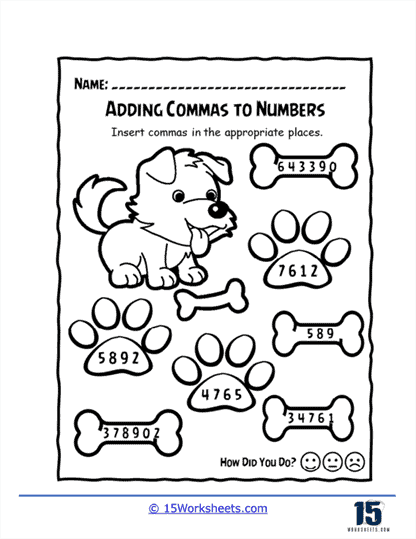Adding Commas to Numbers Worksheets
About These 15 Worksheets
Think of commas as friendly markers that help us read big numbers more easily. Adding commas to numbers worksheets teach us how to use commas to separate thousands, millions, billions, and beyond! Just like when you’re telling a story and pause to take a breath, commas in numbers help us keep track of the digits and understand their values better.
Types of Problems On These Worksheets
1. Comma Placement – The simplest exercise is learning where to put the commas in large numbers. Imagine you have the number 8543291. Without commas, it might look a bit confusing. But when we add commas, it becomes 8,543,291. You’ll practice placing commas correctly in numbers ranging from thousands to billions, making them much easier to read.
2. Identifying Place Values – Another thrilling activity involves understanding place values while dealing with commas. You’ll see numbers like 6,713,859 and need to figure out what each digit represents. The digit 7 is in the millions place, the digit 1 is in the hundred thousands place, the digit 3 is in the ten thousands place, and so on. This exercise helps you grasp the value of each digit and the importance of commas in separating them.
3. Adding and Subtracting with Commas – Numbers love to play with each other, and you’ll learn how to add and subtract them even when commas are involved. When you practice adding 2,354,687 and 1,219,546, you’ll need to line up the digits correctly, including the commas, to get the right answer. This exercise strengthens your math skills while ensuring you’re not baffled by those sneaky commas.
4. Comparing Numbers with Commas – Just as knights compare their armor, you’ll compare numbers, but this time with commas. In this exercise, you’ll see numbers like 9,876,543 and 7,890,123, and you’ll need to figure out which number is bigger or smaller. This helps you understand the magnitude of numbers and practice careful comma placement.
How Each Exercise Helps You
1. Clarity and Readability – Adding commas to numbers makes them easier to read. Just like sections in a book help you navigate the story, commas in numbers guide your eyes and mind through their values.
2. Strong Math Foundation -Mastering commas in numbers prepares you for more complex math tasks. It’s like building a strong foundation for a tall tower. With this skill, you can confidently handle large numbers in calculations.
3. Real-Life Connection – Numbers are everywhere, from your allowance to the population of cities. Learning to use commas helps you make sense of big numbers in real-world situations, like understanding statistics or handling finances.
4. Precision in Communication – Using commas correctly in numbers is a bit like choosing the right words in writing. It ensures that you communicate clearly and accurately, whether you’re reading a big number or writing it down.
Why Do We Place Commas in Numbers?
Imagine you’re reading a long book without any spaces or paragraphs—it would be quite confusing, wouldn’t it? Well, that’s where commas come in when it comes to numbers. Just as spaces and paragraphs help us make sense of text, commas help us make sense of numbers. Let’s delve into the reasons why we place commas in numbers.
Think of commas as friendly guides that help us read large numbers more easily. Numbers like 1000000 might look overwhelming, but if we write it as 1,000,000, suddenly it becomes much clearer. Commas act like signposts, breaking up the number into manageable chunks.
Numbers are like big puzzles made up of tiny pieces, or digits. Commas help us group these digits together, making it simpler to identify the value of each part. For example, in the number 87654321, without commas, it’s tough to quickly see if it’s 8 million, 76 thousand, or something else entirely. But if we write it as 87,654,321, it’s obvious that it’s 87 million, 654 thousand, and 321.
Numbers follow a special pattern called place value, where each digit has a specific value depending on its position. Commas help us understand this pattern by separating digits in groups that represent different place values. For instance, in 3,426,789, the comma separates the millions, thousands, and ones places, making it clear which digits are in each place.
Imagine reading the number 123456789 without any commas. It’s easy to mix up the places and misread the number. But when we add commas, like 123,456,789, it’s crystal clear where each group of digits belongs, preventing confusion and mistakes.
Using commas in numbers is a standard practice. Just as everyone agrees on using periods to separate the whole part from the decimal part in decimals, commas help create consistency and clarity when dealing with large numbers.
In a nutshell, placing commas in numbers is like adding spaces and paragraphs to text-it makes them more understandable and less overwhelming. Commas help us break down large numbers into smaller groups, understand their place values, and read them more smoothly. Whether you’re dealing with large quantities in statistics, understanding finances, or simply writing down a phone number, commas ensure that numbers communicate their values clearly and accurately. So, remember, commas in numbers are your helpful companions in the exciting journey of numerical communication!






